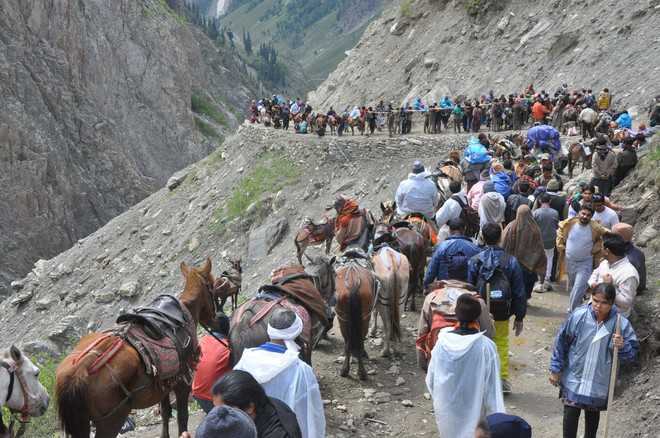India is the sacred land of pilgrimages. There is perhaps no province on this earth where pilgrimage sites do not exist. These pilgrimage centers have been prominent centers of faith and belief since time immemorial. The pilgrimage site named ‘Amarnath’ situated in the Kashmir province holds special significance. In Kalhana’s ‘Rajatarangini’, this pilgrimage is referred to as ‘Amareshwar’. Among the twelve Jyotirlingas of Lord Shiva located in various regions of India – Somnath, Mallikarjuna, Mahakaleshwar, Omkareshwar, Kedarnath, Bhimashankar, Kashi-Vishwanath, and others – ‘Amarnath’ holds extraordinary importance. Among Shiva’s principal abodes, Amarnath is paramount. Hence, Amarnath is called the pilgrimage of pilgrimages.
The Amarnath pilgrimage site is located 141 kilometers northeast of Srinagar city in the Jammu and Kashmir state, at an altitude of 3,888 meters (12,756 feet) above sea level. The cave’s length (depth inward) is 19 meters and width is 16 meters. This cave spreads across approximately 150 feet area and stands 11 meters high. The wondrous splendor of nature, the Amarnath cave, is one of Lord Shiva’s principal religious sites. According to a mythological tale, Lord Shiva chose this very cave to reveal the secret of immortality (the mystery of life and death) to Parvati. The conqueror of death, Mrityunjaya Shiva is immortal, hence also called ‘Amareshwar’. Devotees call ‘Amareshwar’ as Amarnath. Shiva devotees also call him Baba Amarnath or Barfani Baba (the Snow Father).
Amarnath is formed by combining two Hindi words – “Amar” meaning “immortal” and “Nath” meaning “Lord”. According to a mythological story, when Goddess Parvati asked Lord Shiva to reveal the secret of immortality, which he had been hiding from her for a long time, Lord Shiva took Parvati to this cave in the Himalayas to share this secret, ensuring no one else could hear it. Here, Lord Shiva revealed the mystery of immortality to Goddess Parvati.
In the 40-meter high Amarnath cave, water droplets freeze to form a beautiful solid ice formation. Followers of Hinduism consider this icy formation as the Shivalinga. It is said that Lord Shiva left Nandi and the bull at Pahalgam (Bull Village). At Chandanwari, he released the moon from his matted locks, and at the banks of Sheshnag Lake, he left his serpent. On Mahagunas (Mahaganesh Hill) mountain, he left Lord Ganesha. At Panjtarni, he left the five elements: earth, water, air, fire, and sky. Thus, renouncing all worldly things, Lord Shiva performed the Tandava dance there and finally came to the sacred Amarnath cave with Goddess Parvati.
Historians believe that the Amarnath pilgrimage has been continuing for thousands of years, and the significance of Amarnath darshan is found in the Puranas. The Bringesh Samhita, Nilamata Purana, Kalhana’s Rajatarangini, and others consistently mention this pilgrimage. The reference to Amareshwar in the Nilamata Purana reveals that people knew about this pilgrimage even in the sixth-seventh century. One of Kashmir’s great rulers was ‘Zain-ul-Abidin’ (1420-70 CE), whom Kashmiris affectionately call ‘Badshah’. It is believed that he too undertook the journey to Amarnath cave. (Historian Jonaraja has mentioned this.)
Akbar’s historian Abul Fazl (16th century) also mentioned in Ain-i-Akbari that Amarnath is a sacred pilgrimage site. In the cave, an ice bubble forms that gradually grows daily for 15 days and becomes more than two yards high. As the moon wanes, it too begins to diminish, and when the moon disappears, the Shivalinga also vanishes. Swami Vivekananda visited the Amarnath cave on August 8, 1898, and later said with emotion, “I truly felt that the ice linga was Shiva himself. I have never seen anything so beautiful, so inspiring, nor have I enjoyed any religious site’s journey so much.”
The best time for this pilgrimage is during Guru Purnima and Shravan Purnima. The Jammu and Kashmir government has provided all facilities along the route for the convenience of devotees/pilgrims so that devotees can easily complete their Amarnath journey. Bus service is also available from Jammu to Pahalgam (7,500 feet). The government officially organizes the pilgrimage in collaboration with the Shri Amarnath Shrine Board. The government agency provides all expected conveniences to devotees during the journey, including woolen clothes, food, tents, and telecommunications facilities. Additionally, many social service organizations along the route to the cave also arrange food and tents or pavilions for devotees to rest. Helicopter service is now available from the lower camp to Panjtarni (6 kilometers from the cave).
The Amarnath pilgrimage begins from the Dashnami Akhara in Srinagar on the fifth day of the Shravan month, stops at Pahalgam, and resumes on the twelfth day. During the Shravan month, lakhs of people from different provinces come here to have darshan of the sacred ice linga. As mentioned earlier, water droplets from ice fall here and there in the cave, and there is a place where these droplets form a Shivalinga approximately ten feet high. With the waxing and waning of the moon, the size of this ice linga also changes, reaching its full form on Shravan Purnima and gradually diminishing until the new moon. The subject of wonder is that while raw, crumbly ice is generally visible in the cave, this Shivalinga is made of solid ice. At some distance from the main Shivalinga, separate ice linga forms of Ganesha, Bhairava, and Parvati are also visible.
There are generally two routes to reach the Amarnath cave: first, the Pahalgam route, and second, the Sonamarg-Baltal route. The Pahalgam route is relatively convenient, while the Baltal route, though only 14 kilometers from the Amarnath cave, is extremely difficult. Generally, pilgrims undertake the Amarnath journey via the Pahalgam route.
The distance from Pahalgam to Amarnath is 45 kilometers. This pilgrimage route has three main night halts: Chandanwari, Sheshnag, and Panchtarni. The first halt is Chandanwari, which is 12.8 kilometers from Pahalgam. Pilgrims spend the first night here. On the second day, the climb to Pissu Valley begins. The next halt is at Sheshnag, 13 kilometers from Chandanwari. This climb is extremely difficult. Here one can see Pissu Valley. The Pissu Valley route is very difficult throughout the journey. Pissu Valley is at an altitude of 11,120 feet above sea level. After this, pilgrims reach Sheshnag. The lake, spread over approximately one and a half kilometers in length, is extremely beautiful. Pilgrims rest here at night. On the third day, the journey resumes. On this route, one must cross the Mahagunas pass. The entire path from Mahagunas to Panchtarni is downhill. This place became famous as Panchtarni due to five small rivers flowing here. The sacred cave of Amarnath is 6 kilometers from Panchtarni. Upon reaching near the cave, camp is set up, and in the early morning, after worship and other rituals, devotees become beneficiaries of merit after having darshan of Shiva’s ice linga.
As mentioned earlier, Shiva gave Parvati the teaching of immortality in this very cave. When he was giving her this teaching, a pair of doves was also present nearby who heard this teaching. Devotees call them immortal birds who became immortal by hearing the teaching of immortality given by Shiva to Parvati. Even today, those devotees who see this pair of doves are believed to have received direct darshan of Shiva-Parvati. Many meritorious fruits are obtained from this auspicious pilgrimage completed annually. It is believed that great merit is obtained from Amarnath darshan and worship.
The scriptures place special emphasis on sense control, which leads to liberation. It is described in the scriptures that the Amarnath pilgrimage grants liberation even without ‘restraint’ because due to the difficulties encountered during the journey and the various mixed experiences of joy and sorrow upon reaching the destination, the pilgrim realizes various worldly sufferings, and simultaneously, his heart becomes so composed from the darshan of Shiva’s ice linga form that he attains liberation without sense control. The scriptures also mention that the darshan of Amareshwar/Amarnath is extremely merit-giving. Baba Amarnath destroys all the worldly ailments of his devotees, namely: spiritual, physical, and divine sorrows.
An extremely important and practical fact related to the Amarnath pilgrimage is that this journey also promotes mutual harmony. Among people coming from various provinces for Shiva’s darshan, a feeling of equality develops, conversations occur between speakers of different languages, a spirit of brotherhood develops, and geographical knowledge of various provinces is exchanged. Thus, the Amarnath pilgrimage can be considered a combination of faith, knowledge, and harmony, in addition to being a pilgrimage.
The writer is Former Fellow, IIAS, Rashtrapati Nivas, Shimla, Ex-Member, Hindi Salahkar Samiti, Ministry of Law & Justice and Senior Fellow, Ministry of Culture, GOI






